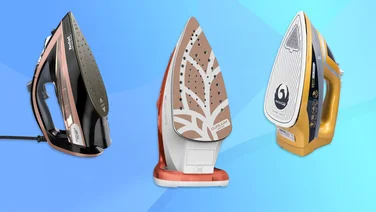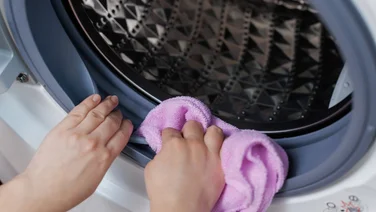To help us provide you with free impartial advice, we may earn a commission if you buy through links on our site. Learn more

We’ve all been there: you’ve found the care label in an item that you need to launder, but you’re not quite sure what those little care symbols mean.
This guide is here to help. We’ll tell you exactly what each of the care label symbols means, and how you can use them to look after your things.
The laundry care symbols used on most garments (and other washables) are managed by GINETEX (The International Association for Textile Labelling), which is represented in this country by the UK Fashion & Textile Association (UKFT).
Under GINETEX’s management, the same set of care label symbols is used in many parts of the world. The symbols are defined within an international standard: ISO 3758. These are the ones we’ll talk about in this article.
In recent years, a square “natural drying” symbol has come into common use on UK care labels, providing instruction on how to dry an item, for example “line dry” (indicated by a curved line from one top corner to the next) or “dry flat” (represented by a single horizontal line). You’ll probably find this symbol on care labels in your newer items, but not older ones.
READ NEXT: The best washing machines to buy
How to read care label symbols
There are seven basic symbols that make up the care label system. They might look a little empty right now – but we’ll explain more about each of them later:
| Symbol | What it relates to |
| Wash tub | Washing by machine or hand |
| Triangle | Bleaching with chlorine |
| Iron | Ironing |
| Circle | Dry cleaning |
| Circle within a square | Tumble drying (after washing) |
| Square | Drying |
| Cross with diagonal lines | Do not |
These basic symbols are modified to provide specific guidance on how to treat an item.
The wash symbol

Inside the wash symbol, you’ll see a number – e.g. 40, 50, 60 or 95.
The number tells you the textile’s maximum wash temperature in degrees Celsius (℃). So, if the wash symbol shows the number ‘50’, you shouldn’t wash the textile at a setting higher than 50℃.
Underlining is also used to add detail to the wash symbol. It denotes the maximum intensity of the laundry cycle that should be used with the textile. (The intensity of a cycle depends on the programme used, especially the spin speed.)
- No underline: If there is no underlining, the item can be washed at any intensity up to the maximum setting of a normal washing machine.
- Single underline: If there is one line beneath the wash symbol, the item can be washed at any intensity up to medium.
- Double underline: If there are two lines beneath the wash symbol, the item can be washed only at a low intensity setting.
For example, if the care label on your shirt has a double-underlined wash symbol, then you can only wash the shirt on a low intensity setting, such as a “delicates” programme.
Another common modification of the wash symbol is the addition of a hand. This means the textile can only be hand-washed (or sometimes in a washing machine with a hand-wash setting).
READ NEXT: How to wash shoes in the washing machine
The bleach symbol

The triangular bleach symbol has three versions:
- An “empty”, unmodified triangle means any household bleach can be used on the textile.
- A triangle with two lines across the inside means only oxygen/non-chlorine bleach can be used.
- A triangle with a cross through it means bleach can’t be used.
The iron symbol

The iron symbol has five versions. One difference between them is the number of dots in the centre of the “iron”:
- An iron symbol with three dots means you can iron the textile on a hot setting, or lower.
- An iron symbol with two dots means you can iron the textile on a medium or low setting – but not on a hot setting.
- An iron symbol with one dot means you can iron the textile only on a low setting.
- An iron symbol with a small protruding shape and a cross underneath it means steam should not be used during ironing.
- An iron symbol with a cross through it means the item should not be ironed
READ NEXT: The best steam generator irons to buy
The dry clean symbol

A care label symbol featuring a circle (without a square around it) gives information on how the item should be dry cleaned.
The letters contained within the circle (or a bar beside it) will tell your chosen professional dry cleaner how exactly to dry clean or wet clean the textile.
A circle with a cross through it means the item should not be dry cleaned.
The tumble dry symbol

The basic tumble dry symbol consists of a circle within a square. It can be modified with dots or a cross to provide further information.
- The basic tumble dry symbol (a circle inside a square) means the item can be tumble dried.
- One dot inside the tumble dry symbol means only a low temperature setting can be used.
- Two dots inside the tumble dry symbol mean a high temperature setting can be used.
- A cross through the tumble dry symbol means the item should not be tumbled dried.
READ NEXT: The best tumble dryers to buy
The dry symbol

The square-shaped dry symbol (without a circle inside it) instructs on which natural drying method to use.
A blank square is never used; instead, you’ll see one of the following variants:
- A square with a curved line between the two upper corners means the item should be dried on a washing line.
- A square with three vertical lines inside it means the items should be drip dried.
- A square with one horizontal line inside it means the item should be dried flat.
- A square with two diagonal lines towards its upper-left means the item should be dried in the shade.
- A square with a cross through it means the item should not be dried. (If this is the case, the item probably shouldn’t be washed either.)
A different type of drying symbol depicts a twisted textile with a cross through it. This means the item should not be wrung dry.
READ NEXT: The best clothes airers to buy
How to use care label symbols
The idea is simple: you read the care label on your item of clothing (or other textile product), interpret the symbols and then treat the item appropriately when the time comes to wash, dry, iron or treat the item.
Now that you’ve researched what the care symbols mean, you’ll hopefully be able to read care labels more quickly and easily. Care label symbols are a tiny language unto themselves – and as with any language, it takes practice to become fluent.
To help you out or add detail, textile manufacturers often include additional written instructions on the care label – and you should follow these just as carefully as the symbols. For example, the label might tell you that “colours may transfer onto other garments and upholstery” or to “wash inside out”.
Some smart washing machines, washer-dryers and tumble dryers have apps which can scan care labels and tell you exactly which wash or dry settings to use – as is the case with Haier’s I-Pro Series 5 HW100-B14959U1.
READ NEXT: The best smart washing machines to buy
Putting care label instructions into practice
Once you’ve interpreted the symbols on a care label, you can go ahead and choose the best washing or drying method for the item of laundry.
This can be challenging, as even the best washing machines and tumble dryers sometimes display symbols that are different to the ones used on UK care labels. The best solution is to read the appliance’s instruction booklet carefully, and find out the best settings or programmes to use for the relevant treatment or textile.
If in doubt, contact the appliance manufacturer’s customer support. Here are some quick links to help you contact some leading manufacturers:
- Bosch customer support
- Haier customer support
- Whirlpool customer support
- Sharp customer support
- Samsung customer support
- Hisense customer support
- Beko customer support
- Miele customer support
You should always fully understand the care instructions on a textile before you wash or dry any item.
Bear in mind that the care label symbols provide information on the maximum permitted treatments for your textiles. Sometimes, the smart choice is to choose a slightly gentler setting than the care label denotes.
With that said, manufacturers are supposed to choose the symbols for their care labels after having the garment professionally assessed by a “test house” – so there’s good reason to trust the information given.
Care label instructions sometimes get rubbed off, after repeat wear of the item. So, it’s a good idea to document the care label soon after purchasing a new garment or washable textile. A photo taken with a smartphone would do nicely. If you’ve lost the care label instructions from a washable product, you may be able to find out how to care for the item by contacting the retailer or manufacturer.
READ NEXT: The best Bosch washing machines to buy
What to do when there’s an unfamiliar symbol on the care label
While a majority of garments and washable textiles sold in the UK use the familiar ISO 3758 care label symbols that we’ve described in this guide, you might encounter an unusual care symbol every now and then.
If you’ve bought clothing or other textiles from another country, you may find some exotic symbols on the care label. For example, the USA’s care label system includes some different symbols relating to drying methods.
So, if you think your item of clothing might have been made or sold overseas, look up the care label system used in the retailer or manufacturer’s home country, and see if you can decipher your mystery symbol.
Another way to identify a care symbol is to take a photo of the symbol using your smartphone (showing only the relevant part of the care label), and do a reverse image search with it via the Google app or the Chrome app. With a bit of luck, you’ll find the same symbol in other people’s photos, along with an explanation of its meaning.
Finally, the basic care label symbols and their variants are sometimes modified with additional words and numbers. These details are often intended for the use of professional dry cleaners.






